
China’s Belt and Road Initiative (“BRI”) is receiving increasing attention. What is less well-known is that a second trade and investment project is being developed in Asia, spearheaded by India and Japan: the Asia Africa Growth Corridor (“AAGC”). Interestingly, a range of factors from geopolitics to economics, politics, and geography are bringing these two nations closer together.
There are trade pacts spearheaded by a single country like China’s BRI or the U.S. and NAFTA and there are multilateral trade pacts like the EU or ASEAN. However, there are few such projects championed by two equal partners. What is driving this Indo-Japanese cooperation? How strong can it become and what are the implications of such a partnership? There are a number of geopolitical drivers of this cooperation. Both countries are stepping up their international profiles: India is emerging from its non-interventionist isolationism and Japan is moving away from the postwar condition of pacifism combined with U.S. protection. As President Trump has indicated that the U.S. will be less interventionist worldwide, regional powers, especially U.S. allies such as Japan, Germany, and Saudi Arabia are stepping up. Both Japan and India feel competition because of China’s growing trade relations. The AAGC is often framed as an answer to the BRI. As the number two and number three economy is Asia, they both naturally align against the growing number one.Economics also brings them together. India has a vast growing market but lacks infrastructure and investments. Japan has a powerful industrial export sector that needs new growth markets. The current energy and infrastructure projects are examples of this synergy. Furthermore, both countries are energy-poor, which aligns them on global energy policy. Socio-political similarities are also notable. Both countries have democratic systems, which in the past already led to regional cooperation with Australia. Both countries have a ‘soft’ profile as well: India because of its culture and Japan because of its pacifism. These two factors also characterize the AAGC. In contrast to the BRI, infrastructure plays a small part. Instead, the AAGC promises to focus on enhancing people’s skills and capabilities, achieving sustainable growth goals, people-to-people ties, and inclusive growth.The final dimension that brings them together is geography. Both countries are close to, but not part of the Eurasian landmass. This is the region that China and Russia occupy. Japan’s islands are along the coast of this landmass. The Himalayas and jungles cut the Indian subcontinent off from Eurasia, hence making its connections with the world primarily maritime. In other words, we can see India and Japan as ‘island nations’, which is why the pivot of their cooperation is the Indian Ocean. An analogy can be drawn with the 20th century alliance between England and the U.S. to counter Eurasian power from the Atlantic Ocean.Overall, the drivers in different domains show that there are strong forces bringing India and Japan together. The announcement of the AAGC is a first step of this future alliance.

